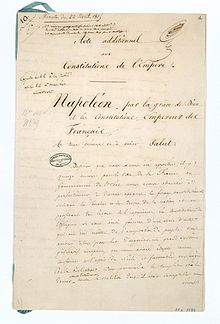
The 1810s was a decade of the Gregorian calendar that began on January 1, 1810, and ended on December 31, 1819.

Louis XVIII, known as the Desired, was King of France from 1814 to 1824, except for a brief interruption during the Hundred Days in 1815. He spent 23 years in exile from 1791: during the French Revolution and the First French Empire (1804–1814), and during the Hundred Days.

The Second Bourbon Restoration was the period of French history during which the House of Bourbon returned to power after the fall of the First French Empire in 1815. The Second Bourbon Restoration lasted until the July Revolution of 26 July 1830. Louis XVIII and Charles X, brothers of the executed King Louis XVI, successively mounted the throne and instituted a conservative government intended to restore the proprieties, if not all the institutions, of the Ancien Régime. Exiled supporters of the monarchy returned to France but were unable to reverse most of the changes made by the French Revolution. Exhausted by decades of war, the nation experienced a period of internal and external peace, stable economic prosperity and the preliminaries of industrialization.

The Hundred Days, also known as the War of the Seventh Coalition, marked the period between Napoleon's return from eleven months of exile on the island of Elba to Paris on 20 March 1815 and the second restoration of King Louis XVIII on 8 July 1815. This period saw the War of the Seventh Coalition, and includes the Waterloo Campaign and the Neapolitan War as well as several other minor campaigns. The phrase les Cent Jours was first used by the prefect of Paris, Gaspard, comte de Chabrol, in his speech welcoming the king back to Paris on 8 July.
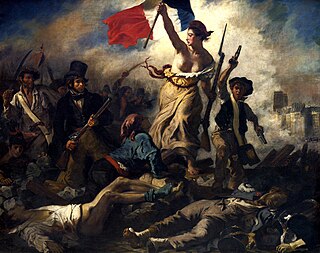
The French Revolution of 1830, also known as the July Revolution, Second French Revolution, or Trois Glorieuses, was a second French Revolution after the first in 1789. It led to the overthrow of King Charles X, the French Bourbon monarch, and the ascent of his cousin Louis Philippe, Duke of Orléans. After 18 precarious years on the throne, Louis-Philippe was overthrown in the French Revolution of 1848.
The Conservative Order was the period in political history of Europe after the defeat of Napoleon in 1815. From 1815 to 1830, a conscious program by conservative statesmen, including Metternich and Castlereagh, was put into place to contain revolution and revolutionary forces by restoring the old orders, particularly the previously-ruling aristocracies. On the other hand, in South America, in light of the Monroe Doctrine, the Spanish and the Portuguese colonies gained independence.

The Constitution of the Year VIII was a national constitution of France, adopted on 24 December 1799, which established the form of government known as the Consulate. The coup of 18 Brumaire had effectively given all power to Napoleon Bonaparte, and in the eyes of some, ended the French Revolution.

The periods of Restoration and Regeneration in Swiss history lasted from 1814 to 1847. "Restoration" is the period of 1814 to 1830, the restoration of the Ancien Régime (federalism), reverting the changes imposed by Napoleon Bonaparte on the centralist Helvetic Republic from 1798 and the partial reversion to the old system with the Act of Mediation of 1803. "Regeneration" is the period of 1830 to 1848, when in the wake of the July Revolution the "restored" Ancien Régime was countered by the liberal movement. In the Protestant cantons, the rural population enforced liberal cantonal constitutions, partly in armed marches on the cities. This resulted in a conservative backlash in the Catholic cantons in the 1830s, raising the conflict to the point of civil war by 1847.
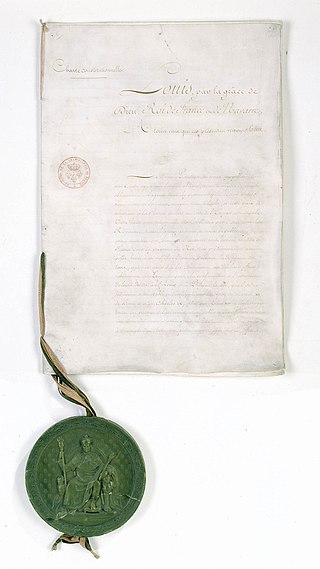
The French Charter of 1814 was a constitutional text granted by King Louis XVIII of France shortly after the Bourbon Restoration, in form of royal charter. The Congress of Vienna demanded that Louis bring in a constitution of some form before he was restored. After refusing the proposed constitution, the Constitution sénatoriale, set forth on 6 April 1814 by the provisional government and the Sénat conservateur, Louis Stanislas Xavier, count of Provence, bestowed a different constitutional Charter, on 4 June 1814. With the Congress of Vienna's demands met, the count of Provence was officially named Louis XVIII, and the monarchy was restored.
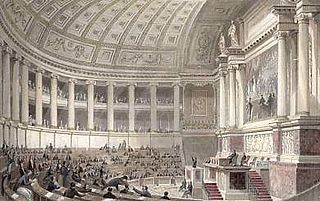
Chamber of Deputies was a parliamentary body in France in the nineteenth and twentieth centuries:
The Treaty of Chaumont was a series of separately-signed but identically-worded agreements in 1814 between the Austrian Empire, the Kingdom of Prussia, the Russian Empire and the United Kingdom. They were dated 1 March 1814, although the actual signings took place on 9 or 19 March. The treaty was intended to draw the powers of the Sixth Coalition into a closer alliance in case France rejected the peace terms they had recently offered. Each power agreed to put 150,000 soldiers in the field against France and to guarantee for twenty years the European peace against French aggression.

The First Restoration was a period in French history that saw the return of the House of Bourbon to the throne, between the abdication of Napoleon in the spring of 1814 and the Hundred Days in March 1815. The regime was born following the victory of the Sixth Coalition as part of the campaign of France, while the country was in conflict during the First Empire. While the Allied powers were divided over the person to be placed on the throne of France, a subtle game was established between the Bourbons in exile, the French institutions, and the foreign powers, before the abdication of Napoleon on 6 April opened the way to Louis XVIII, brother of Louis XVI, who returned to Paris at the end of the month and moved to the Tuileries Palace.

The First French Empire, officially the French Republic, then the French Empire after 1809 and also known as Napoleonic France, was the empire ruled by Napoleon Bonaparte, who established French hegemony over much of continental Europe at the beginning of the 19th century. It lasted from 18 May 1804 to 3 May 1814 and again briefly from 20 March 1815 to 7 July 1815, when Napoleon was exiled to St. Helena.

The Acte de déchéance de l'Empereur was a law passed by the Sénat conservateur on 2 April 1814, which deposed Napoleon I as Emperor of the French.

The Government of the first Bourbon restoration replaced the French provisional government of 1814 that had been formed after the fall of Napoleon. It was announced on 13 May 1814 by King Louis XVIII. After the return of Napoleon from exile, the court fled to Ghent and the government was replaced by the French Government of the Hundred Days on 20 March 1815.

The French Government of the Hundred Days was formed by Napoleon I upon his resumption of the Imperial throne on 20 March 1815, replacing the government of the first Bourbon restoration which had been formed by King Louis XVIII the previous year. Following the defeat of Napoleon at the Battle of Waterloo and his second abdication on 22 June 1815 the Executive Commission of 1815 was formed as a new government, declaring the Empire abolished for a second time on 26 June.
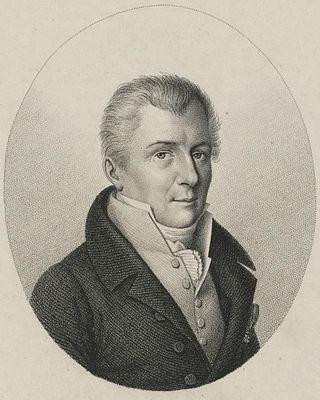
Emmerich Joseph Wolfgang Heribert de Dalberg, 1st Duke of Dalberg was a German diplomat who was elevated to the French nobility in the Napoleonic era and who held senior government positions during the Bourbon Restoration.
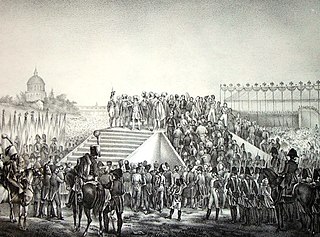
The Champ de Mai was a public assembly held by Napoleon on the Champ de Mars, Paris, a large open area near the École militaire, on 1 June 1815. This was during the Hundred Days, the period between Napoleon's return from exile and the restoration of the Bourbon kings following his failed Waterloo campaign. The objective of the Champ de Mai was to gather public support behind Napoleon's Charter of 1815, a constitutional reform that promised a more liberal government than under his earlier rule. The Charter was put to the citizens in a constitutional referendum and the results of this would be announced during the ceremony by representatives of the electoral college.
Legislative elections were held in France between 8 and 22 May 1815 for the period of the Hundred Days. The elections were held to appoint deputies to the Chamber of Representatives established by the Additional Charter of 22 April 1815. The elections were the first since April 1799 and last of the 'republican system' until the Charter of 1830.
The Liberals was a short lived French liberal political party which was active in several elections before being absorbed into the Doctrinaires, a fellow constitutional monarchy party. Several members of the Liberals eventually went on to serve in the Movement Party and even later in the Orléanist parties. The precedent set by the party would help form modern French classical liberalism, something used in the modern centre-right Republicans party.
